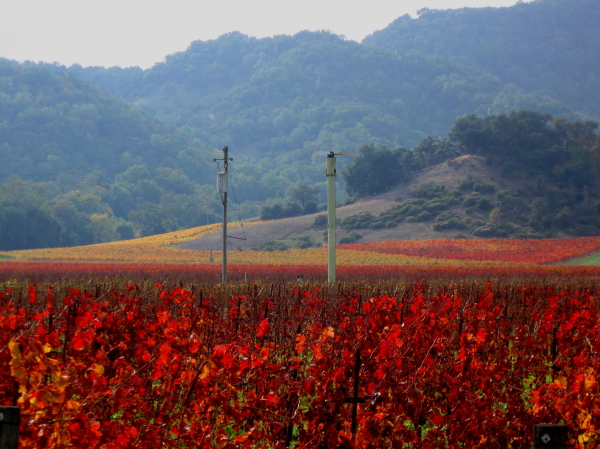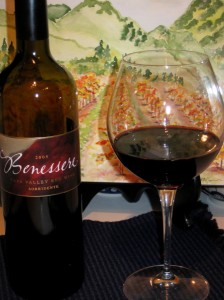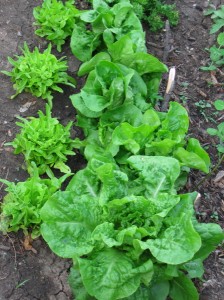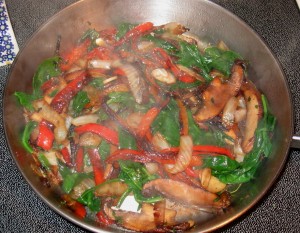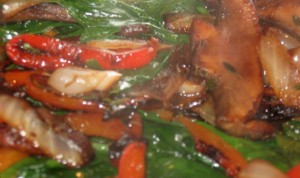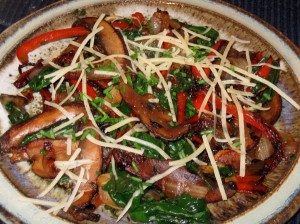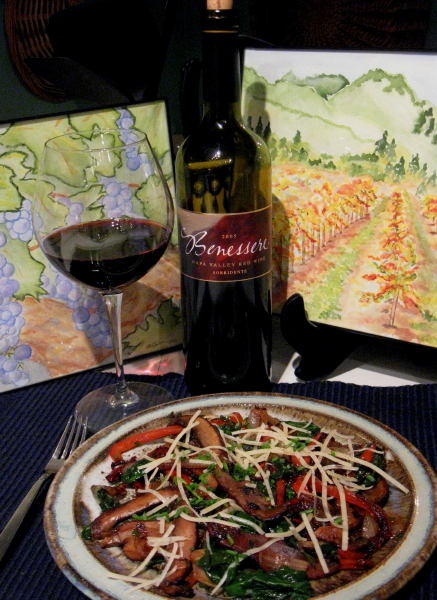Nov 14 2012
From the Vine to a Wine with a Smile
Red blend wines often receive moments to shine simply because of their unique nature. A little of this, a little of that and a winery creates a bottle of wine that reflects its culture. Provided that you like what the winemaker bottles, it then allows the winery to set itself uniquely apart from the rest of the pack.
Benessere Vineyards (“Benessere”) situated north of the town of St. Helena in Napa Valley is a winery that is best known for making Italian-inspired varietals of wine. To keep in theme, its red blend wine “Sorridente” featurs a unique Italian red grape, Aglianico. Depending on the vintage that you have or can acquire, its blend composition will vary, but Aglianico is consistently a shining star in this blend. Sorridente means “smiling” and with a sip of Benessere’s Sorridente, the wine will have you doing just that.
This week I chose to feature Benessere’s 2005 Sorridente from my wine collection. Some red wines are enjoyable whether they are poured when released by the winery or emerge from your wine cellar years later. With aging, the wine changes and depending on the varietal, where the fruit is grown, the quality of the fruit and accompanying vintning and your personal preference, an aged wine may please your palate more.
In the case of Benessere’s 2005 Sorridente, its composition included Merlot, Aglianico and a small amount of Cabernet Sauvignon. The Aglianico grape is best suited for aging, yet the Merlot is a softer grape and may or may not age comparably. With this knowledge, I was simply curious as to how the wine would age. Seven years post-harvest, my suspicions were confirmed . . . but before I reveal what those suspicions were, first let us dive a bit more into some background about the Aglianico grape.
Aglianico, (pronounced “all-yee-on-ee-co”) as I initially mentioned, is a grape that ages well. It is a dark-skinned red wine grape that is primarily grown in the Campania region near Naples, Italy. The grape itself is made into red wine that has high acidity, strong tannins and firm structure. The Aglianico grape is a powerhouse of a wine grape as it buds early, grows best in dry climates with an abudance of sunshine and thrives in rocky, volcanic soil. Because this particular grape vine does not need an abudance of water and further prefers soil that makes the vine struggle to get its water, the grapes produced will be quite tannic. The tannins lend to making wine with a solid structure and similarly, need aging to settle down in the bottle. Aglianico’s flavor profile also is a clear distinct red cherry flavor. Given the grape’s tenancity with acidity, as the wine ages, the fruit will remain distinctly present making one wonder if somewhere along the lines that this varietal found the fountain of youth. The lip-pursing tartness of the wine will dissipate with age. Time is clearly on Aglianico’s side.
Merlot, on the other hand, is a softer red wine grape. It is often referred to as a mid-palate grape and frequently rounds out the palate experience in many a bottle of Cabernet Sauvignon. It can age well, too, however, as it does, it will become increasingly softer, albeit more velvet-like.
While it is clear that Aglianico itself should be aged, knowing the Merlot content of this vintage made it seem that perhaps bottle-aging Benessere’s 2005 Sorridente would be a “toss-up”. Ultimately, it is a personal decision. For me, the wine has long been a favorite. It is unique simply because of the varietals used in the blend. However, Aglianico itself is not widely grown. Only a few growers in the state of California grow Aglianico. While Benessere does not grow the grape, its neighbor, Collins Vineyards (“Collins”) does. Couple in the fact that Benessere has had a long-standing relationship with Collins, that sense of neighborliness is the final ingredient to make Sorridente special and worthy of bottle-aging for me.
Today, the wine has a rich garnet color in the glass. The bouquet uniquely offers a slight earthiness, distinct aromas of Bing cherries, candied plum and a faint whisp of vanilla. The palate is initially dominated by big flavors of tart cherries, but as the wine opens and breathes, the cherry flavor becomes sweeter and the soft cradling notes of Merlot come forth to round out the feeling of the wine in the mouth.
While this wine would pair well with lamb, or even a Tuscan style steak, but for this week’s pairing, I opted to go vegetarian:
- Kristin’s Late Harvest November Vegetable Plate
The idea behind this week’s food is simple: before winter arrives, what is left to harvest from the garden? November is an interesting time period for vegetable gardening (depending on where you are in the United States). Summer crops have long finished and plants may still have a red bell pepper or tomato or two to be picked before the plant gives up the ghost. Herbs and chives love the cooler temperatures and dewy mornings so they are lush and fragrant. If you fear that you cannot find them beneath fallen autumn leaves, no worry, your nose will easily lead you to them. Cool weather crops have taken off and brussel sprouts are waiting for harvest but the sight of green leafy vegetables have returned and spinach and lettuces are available. If you find yourself in Northern California, wild mushrooms are in season.
My ensemble includes sweet red bell pepper, fresh garlic, sweet onion, portabella mushroom, fresh spinach and plenty of fresh lemon thyme and chopped chives. Such a simple combination but depending on the method of preparation, it is sweet, savory and flavorful all at once. Onions are slowly sweated on the stove to caramelize with thin slices of garlic tossed in at the last minute to slowly roast and sweeten. Portabella mushroom and red bell pepper are sautéed and then tossed in balsamic vinegar also to carmelize. Thrown into the mix is lots of lemon thyme leaves. Aromas of lemon thyme fill and perfume the kitchen, lingering throughout the home. This herb alone offers a lovely herbaceousness that fits comfortably with nature yet freshens the air to remind one that there are still things yet to harvest in the garden.
Similarly a sautéed vegetable medly such as this can be just as fitting for fall as the root vegetables that we so often race to. Trying this combination as I have, you will be happy to shelve the root vegetables until winter and still enjoy something satisfying, filling and surprisingly light.
Once the main vegetables are caramelized and mixed into one skillet, many handfuls of fresh spinach leaves are tossed on top before the pan is lidded for two minutes. The spinach barely wilts while retaining its color. The flavors and aromas mix and represent a meld of earth and herbaceousness.
The vegetables look fantastic on an earth-toned pottery plate and then are dressed with coarsely grated fresh Parmesan and fresh chopped chives.
This simple but flavorful dish pairs fantastically with Benessere’s 2005 Sorridente and more over, with the grape varietal Aglianico. With the food, the Aglianico embraces the caramelized sweet red peppers because of its acidity. The cherry flavors in the wine reciprocally respond and become instantly sweet, sugared candy making one wonder, “Is this dinner or dessert?” The mushrooms are tender (not chewy) and release a gentle earthy flavor allowing the palate to pay homage to fall.
In sum, this is a terrific simple sustainable meal. It is easy to prepare although you do have to master several burners going at once. The ingredients are easily found, if not already in your kitchen or garden.
This is also a perfectexample of how a meal can take a quirky red wine blend and show off its absolute finest attributes. When you accomplish this, non-mainstream varietals are less intimidating and gain immense respect in the environments where they should be served.
And most importantly, this is a fantastic way to bring a little bit of the flavors of Napa Valley into your home. Cheers!
Comments Off on From the Vine to a Wine with a Smile
